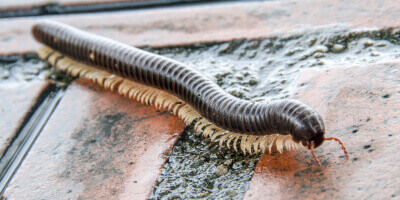Sometimes just understanding a bug can help it become less scary. So, while millipedes and their many, many legs can seem intimidating, read on for facts that will make them less so!
How Many Legs Does a Millipede Have

Despite their names, millipedes don’t have even close to 1,000 feet. Most species have fewer than 100 legs. Their legs are tucked under the body and so they are difficult to see. The number of body segments varies with the species (estimated in the range of 10,000 species), but the number of pairs of legs generally ranges between 40 and 400. The females of a nearly extinct species of California millipede have up to 750 legs. But now, researchers have discovered a species of millipede that can exceed the definition. The animal was found living as deep as 60 meters below the surface of a desert in Western Australia. Thank goodness we aren’t there. Australia seems to have all the best (depending on how you look at it) creepy crawlies!
Are Millipedes Poisonous
We have good news for you! Millipedes are not poisonous, but many species have glands capable of producing irritating fluids that may cause allergic reactions in some individuals. The defensive sprays of some millipedes contain hydrochloric acid that can chemically burn the skin and cause long-term skin discoloration. But those millipedes aren’t in our area, so it is super rare
Centipede vs Millipede
There are many differences between millipedes and centipedes. Millipedes have two pairs of short legs on each body segment, a rounded body, and a hard external skeleton. Like we said above, their legs are tucked under the body and difficult to see the number of them. The number of pairs of legs generally ranges between 40 and 400. Centipedes have only one pair of legs on each body segment, and they’re easily spotted sticking out from their flattened bodies. The number of body segments varies with the species (estimated in the range of 8,000 species), and the pairs of legs vary from 15-177, plus or minus one. Centipedes have an odd number of pairs of legs with the last pair trailing behind the body.
Millipedes have short antennae and move in slow waves, burrowing and eating their way through moist leaf clutter, fungi, and decayed plant material on the ground. As they plow through the soil, munching on dead plants and other vegetation, they aerate and enrich the soil, much like earthworms. Centipedes have long antennae, and their back legs are nearly as long as their antennae. The antennae help them locate their prey, and their first pair of legs, modified into venomous claws, help them capture and paralyze their prey. Centipedes eat spiders, insects, worms, and other arthropods. The Amazonian giant centipede is over twelve inches in length and is said to eat frogs, mice, and lizards. No thanks!
Millipedes in House
Normally, Millipedes prefer to live in cool, damp places such as under stones, leaf mold, mulch, compost heaps, piles of grass clippings, and brick pathways. They won’t really survive inside. So, as much as you don’t want them I there, they don’t want to be either! At certain times of the year millipedes become restless and migrate from their normal living places. That’s when you may see millipedes in the house. Usually, they appear in window wells, basements, garages, and other places where they become an annoyance. These migrations are often associated with cooler weather or following heavy rains but may also be a function of mating behavior.
How to Get Rid of Millipedes
Millipedes don’t survive inside for more than a few days. So, if they’re inside your home or business, you can be sure they won’t be there for long unless there’s plenty of moisture. If you do see a lot of millipedes, you should bring in a plumber to check for leaks as well as have professional exclusion work done like sealing cracks and crevices in foundations. But besides looking weird, they don’t cause any problems. Most people bring in an exterminator for millipedes just because they don’t want them there! So, the major problem they cause is fear. But you may not ever need millipede treatments unless you see a lot of them.